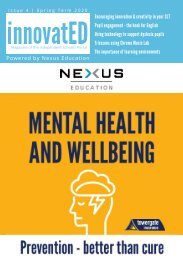innovatED - Issue 2
You also want an ePaper? Increase the reach of your titles
YUMPU automatically turns print PDFs into web optimized ePapers that Google loves.
Solution Driven Practice<br />
Problem? No problem!<br />
Teacher, Author & Associate, Independent Thinking<br />
Lisa Ashes<br />
Irritation was creeping like a venomous spider up Jo’s spine. Jaw tight<br />
and eye twitching, the ‘new’ lesson planning policy being introduced<br />
was almost enough to induce chair flipping. No chairs were flipped.<br />
This may be the fourth ‘new’ initiative being introduced this week but<br />
Jo knew to keep quiet and add it to the never ending to do list. With so<br />
many Assistant Heads determined to prove their 'value', Jo had no<br />
choice but to crank up the work and crank down the family life.<br />
Jo’s situation sounds hopeless, doesn’t it? Jo can see the problems<br />
mounting but does nothing to stop the nonsense. Jo is not powerless! Jo<br />
experiences the problems but avoids responsibility. The comfort of victim<br />
is tempting when faced with a problem. If you are a victim to the system, a<br />
cog in its chaotic wheel, you are not to blame… Actually, as a cog, you are<br />
allowing the chaos to continue unchallenged. You are always responsible<br />
for your actions, even if that action is inaction. You know that the marking,<br />
lesson planning or whole school behaviour policies are not working but<br />
you do them anyway, using your energy bitching about them in the<br />
staffroom or to your ever-neglected family.<br />
Problems are a part of the struggle of life. If you dream of serenity in your<br />
situation, walking around in a state of Nirvana as the marking pile<br />
magically decreases, the initiatives slip seamlessly into your routines and<br />
every child succeeds without struggle, you will end your days in<br />
disappointment. Problems exist and, as you solve one problem, another<br />
will appear in its place. Accepting this truth is the first step towards finding<br />
comfort in your reality and becoming active in solution driven (not<br />
deluded) practice.<br />
Being comfortable with the existence of problems does not mean passive<br />
acceptance. The struggle involved in the solutions of problems is richly<br />
rewarding… if we see it through to the end. The struggle can lead to<br />
success and success breeds confidence in tackling the next problem that<br />
arises. To face the struggle, you will need to turn on your inner creativity.<br />
You must get rid of creativity blockers such as, “I can’t,” or “It’s not my<br />
place” or “I have already tried and failed.” There is always another way.<br />
You must look again with fresh eyes and question, “How can I solve this to<br />
improve the current situation?”<br />
Classroom Based Problem – The little things that might drive us crazy<br />
in our own rooms<br />
The problem: There were many persistent absentees in class A. When<br />
they returned, the teacher’s time was taken up with re-teaching sections<br />
of work. The pupils always needed extra support because of gaps in their<br />
knowledge and they were showing a distinct lack of independence.<br />
Potential get out clause: It is their own fault for not turning up to school..<br />
Solution: The super stuck wall was designed to provide information<br />
already taught. Essentially, it was folders stuck to a wall with commonly<br />
asked questions about previous learning linked to each folder. When<br />
pupils asked questions, instead of taking up the teacher’s time in reexplanation,<br />
the pupils would be pointed to the wall and asked to find out<br />
the information for themselves.<br />
Review: It took no time at all for the class to get used to the stuck wall.<br />
Preparing the information in hindsight added to the workload of the<br />
teacher. However, once it was established that this was a successful way<br />
to avoid repeating lessons and create independent attitudes to learning,<br />
the teacher began to have this strategy in the initial plans rather than after<br />
the fact.<br />
Wider School – The bigger issues that we could work together to solve<br />
Problem: The ‘stage not age’ class misbehave for everyone. Observing<br />
Helpful tips when supporting parents<br />
their attitudes, the teachers found that they had poor attitudes to learning.<br />
Phrases such as “what’s the point.” and “I can’t read.” were common<br />
excuses to get out of learning. They had experienced failure for so long<br />
that to protect themselves, they hid behind their past attainment as an<br />
excuse never to try.<br />
Potential get out clause: Don’t worry. They are like this for everyone.<br />
16 | <strong>Issue</strong> 2 | www.independentschoolsportal.org






